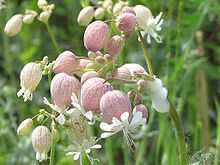Silene vulgaris
| Silene vulgaris | |
|---|---|
 | |
| Scientific classification | |
| Kingdom: | Plantae |
| (unranked): | Angiosperms |
| (unranked): | Eudicots |
| (unranked): | Core eudicots |
| Order: | Caryophyllales |
| Family: | Caryophyllaceae |
| Subfamily: | Caryophylloideae |
| Genus: | Silene |
| Species: | S. vulgaris |
| Binomial name | |
| Silene vulgaris (Moench) Garcke | |
| Synonyms | |
|
Silene cucubalus Wibel | |

Silene vulgaris, or bladder campion is a plant species of the genus Silene of the Pink Family (Caryophyllaceae). It is native to Europe, where in some parts it is eaten, but is widespread in North America where it is considered a weed.[1][2][3]
Gastronomy
The young shoots and the leaves may be used as food.[4] The tender leaves may be eaten raw in salads. The older leaves are usually eaten boiled or fried, sauteed with garlic as well as in omelettes and risotto in Italy. The plant is used as a food in Spain and in Italy, where it is known as sculpit, stridolo, or by the obsolete scientific name Silene inflata.
Formerly in La Mancha region of Spain, where Silene vulgaris leaves are valued as a green vegetable, there were people known as "collejeros" who picked these plants and sold them. Leaves are small and narrow, so it takes many plants to obtain a sizeable amount.
In La Mancha the Silene vulgaris leaves, locally known as "collejas", were mainly used to prepare a dish called gazpacho viudo (widower gazpacho). The ingredients were flatbread known as tortas de gazpacho and a stew prepared with Silene vulgaris leaves. The reference to a widower originated in the fact that this dish was only eaten when meat was scarce and the leaves were emergency or lean-times food, a substitute for an essential ingredient.[5] Other dishes prepared with these leaves in Spain include "potaje de garbanzos y collejas", "huevos revueltos con collejas" and "arroz con collejas".
In Crete it is called Agriopapoula (Αγριοπάπουλα) and the locals eat its leaves and tender shoots browned in olive oil.[6] Common names in Italy are Sciopentin (Veneto) and Venkuz (Friulano).
In Cyprus it is eaten very widely,so much so it has now for some years come back into being cultivated and sold in shops in bunches. Two of the common Cypriot names are Tsakrostoukkia and Strouthouthkia (στρουθούθκια).
See also
- List of plants with edible leaves
- Castilian-Manchego cuisine
References
- ↑ Bladder Campion, Prov. of Ontario
- ↑ Bladder Campion, Prov. of Alberta
- ↑ Bladder Campion, Prov. of Manitoba
- ↑ Fernald, Merritt Lyndon; Alfred Charles Kinsey and Reed C. Rollins (1996). "Bladder-Campion, Maiden's Tears, Snappery, Silene Cububalis (or latifolia)". Edible Wild Plants of Eastern North America. New York City: Dover Publications. pp. 193–194. ISBN 0-486-29104-9. OCLC 33666218. Retrieved 23 February 2009.
- ↑ Gazpacho viudo recipe
- ↑ Kleonikos G. Stavridakis , Κλεόνικος Γ. Σταυριδάκης (2006). Wild edible plants of Crete - Η Άγρια βρώσιμη χλωρίδα της Κρήτης. Rethymnon Crete. ISBN 960-631-179-1.